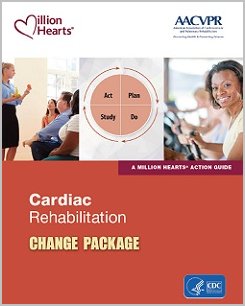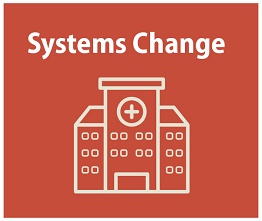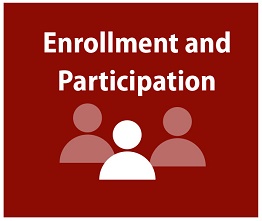Cardiac Rehabilitation Change Package
What Is Cardiac Rehabilitation?
Cardiac rehabilitation (CR) is a comprehensive secondary prevention program designed to improve cardiovascular health following a cardiac-related event or procedure. While there are some instances of inpatient (Phase 1) CR, the vast majority of CR is delivered in an outpatient (Phase 2) setting and, therefore, is the focus of this publication. An optimal CR experience consists of 36 one-hour sessions that include team-based, supervised exercise training, education and skills development for heart-healthy living, and counseling on stress and other psychosocial factors.1
Strong evidence shows that CR programs can benefit individuals who have:
- Had a heart attack.2
- Chronic stable angina.3
- Received a coronary angioplasty or stent.4
- Chronic heart failure.5
- Undergone coronary artery bypass surgery, heart valve replacement or repair, or a heart or heart-lung transplant.6,7
Many insurance companies cover CR for the conditions listed above,* but it is necessary to review each patient’s individual insurance benefits for CR.
Participation in a CR program can reduce the risk of death from any cause8,9 and from cardiac causes,9,10 as well as decrease hospital readmissions.9,11 CR participation also improves functional status,11 quality of life,9–11 and mood.12 Despite these benefits, enrollment in CR remains low, ranging from 10% to 34% in national analyses,13–15 with strong state-by-state geographic variations14,16 and differences by cardiac diagnosis.14,15,17 Barriers to program enrollment are many, occurring at the health system, policy, program, and patient levels. For example, although CR services are widely covered by public and private health insurance plans, co-payments per session represent a financial obstacle for many patients.
Million Hearts®, a national initiative co-led by the Centers for Disease Control and Prevention (CDC) and the Centers for Medicare & Medicaid Services (CMS) with the goal of preventing one million acute cardiovascular events by 2022, has worked with CR professionals to set a national goal of 70% participation in CR for eligible patients.1 Improving awareness about the value of CR, increasing referral of eligible patients, and reducing system and patient barriers to participation are all critical steps in improving the referral, enrollment, and participation rates in CR programs. More importantly, effective remedies have been identified but are not being widely and systematically implemented.
What Can Be Done?
Because CR is so underutilized, program staff, other health care professionals, and others interested in improving rates of referral, enrollment, and/or participation have a unique opportunity to be change agents for their institutions. Improvement in CR utilization and delivery will require one or more champions to identify needed changes, find solutions, and measure and share progress. Multiple champions are likely needed since referral, enrollment, and participation often involve many:
- Processes (e.g., incorporating referral to CR into discharge order sets, integrating health information technology, changing workflows).
- Disciplines (e.g., cardiology, hospital medicine, rehabilitation).
- Professionals (e.g., physicians, nurses, exercise physiologists, administrators).
- Locations (e.g., inpatient units, CR programs, physician offices).
What Is the Cardiac Rehabilitation Change Package?
The Cardiac Rehabilitation Change Package (CRCP) presents a listing of process improvements that CR champions can implement as they seek optimal CR utilization. It is composed of change concepts, change ideas, and tools and resources. Change concepts, sometimes called key drivers, are general notions that are useful in the development of more specific ideas for changes that lead to improvement. Change ideas are actionable, specific ideas or strategies for changing a process. Change ideas can be rapidly tested on a small scale to determine whether they result in improvements in the local environment. With each change idea, the CRCP lists one or more evidence- or practice-based tools and resources that can be adapted by or adopted in a health care setting to improve CR utilization.
The purpose of the CRCP is to help quality improvement teams from hospitals and CR programs put systems and strategies in place that target improved care for more of the eligible patients. The CRCP is broken down into four main focus areas: Systems Change, Referrals, Enrollment and Participation, and Adherence.
Cardiac Rehabilitation Change Package Focus Areas
Read more about the focus areas.
Spread the Word
Use the following sample social media messages and graphic to promote the CRCP through your personal or professional channels.
Facebook/LinkedIn
- Ready to improve #CardiacRehabilitation participation in your hospital or health system? Download the Million Hearts [tag] and AACVPR [tag] change package for ideas and resources to get started. https://bit.ly/2EdKeNpexternal icon #CRSavesLives #MillionHeartsQI
- Despite its lifesaving benefits, many eligible patients do not enroll or participate in #CardiacRehab. Improve enrollment and participation rates with evidence-based tools from the Million Hearts [tag]/AACVPR [tag] Cardiac Rehabilitation Change Package. https://bit.ly/2EdKeNpexternal icon #CRSavesLives #MillionHeartsQI
- Evidence shows that #CardiacRehabilitation benefits patients after a cardiac event or procedure. Implement interventions from the Million Hearts [tag]/AACVPR [tag] Cardiac Rehab Change Package. https://bit.ly/2EdKeNpexternal icon #CRSavesLives #MillionHeartsQI
- Ready to improve #CardiacRehabilitation participation in your hospital or health system? Download this @MillionHeartsUS/@AACVPR change package for ideas and resources to get started. https://bit.ly/2EdKeNpexternal icon #CRSavesLives
- Despite its lifesaving benefits, many eligible patients do not participate in #CardiacRehab. Improve participation rates with evidence-based tools from this change package. https://bit.ly/2EdKeNpexternal icon #CRSavesLives #MillionHeartsQI
- Evidence shows that #CardiacRehabilitation benefits patients after a cardiac event or procedure. Implement interventions from the @MillionHeartsUS/@AACVPR Cardiac Rehab Change Package. https://bit.ly/2EdKeNpexternal icon #CRSavesLives
Shareable Graphic

Learn More
Find additional resources and references
See acknowledgments and contributors
* In addition, individuals with peripheral arterial disease (PAD) and intermittent claudication benefit from supervised exercise therapy (SET). Although SET for PAD is a separate and distinct service from CR, CR programs are an ideal setting for the delivery of SET.
Note: References for citations on this page can be found under Additional Resources and References.





